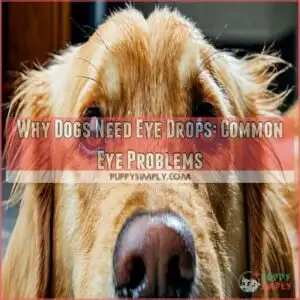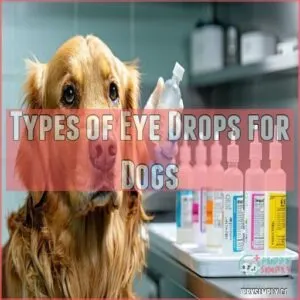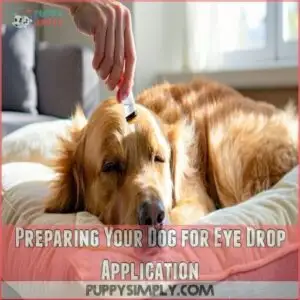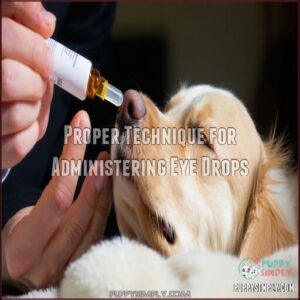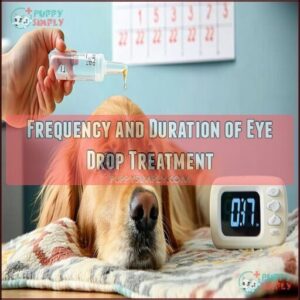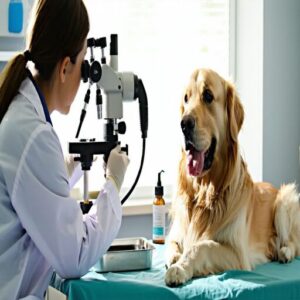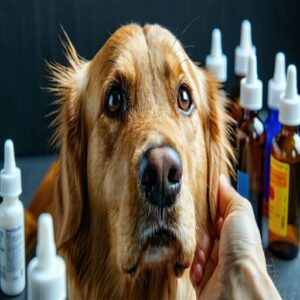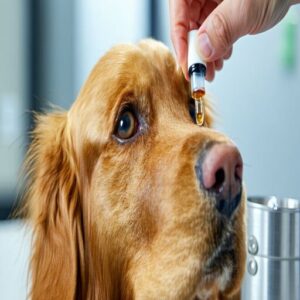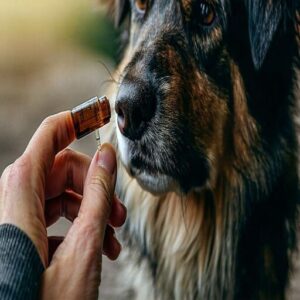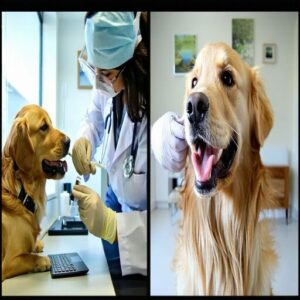This site is supported by our readers. We may earn a commission, at no cost to you, if you purchase through links.
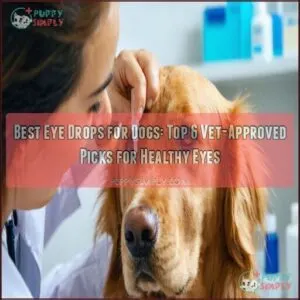 Finding the best eye drops for dogs depends on the issue—dryness, allergies, or infections—but starting with a vet-approved option is always wise.
Finding the best eye drops for dogs depends on the issue—dryness, allergies, or infections—but starting with a vet-approved option is always wise.
For general use, lubricating drops like hyaluronic acid-based formulas or Vetericyn Plus Eye Wash work wonders for soothing irritation and flushing debris.
Dealing with something tricky like conjunctivitis? Prescription antibiotic drops might be necessary.
Got a pup with dry eye? Moisturizing gels can restore comfort.
Remember, your dog’s eyes are as sensitive as your grandma’s teacups, so skip human products, and always check with your vet before trying anything new to keep those puppy-dog eyes sparkling!
Table Of Contents
- Key Takeaways
- Why Dogs Need Eye Drops: Common Eye Problems
- Types of Eye Drops for Dogs
- 6 Best Eye Drops for Dogs
- How to Apply Eye Drops to Dogs
- Choosing The Right Eye Drops for Your Dog
- Frequently Asked Questions (FAQs)
- What is the best eye drops for dogs?
- How to put eye drops or ointments in your pet?
- What are antibiotic eye drops for dogs?
- What are the best eye drops for a dog?
- Can human eye drops be used on dogs?
- What is a home remedy for dog eye drops?
- Which human eye drops are safe for dogs?
- What are the best drops for dry eyes in dogs?
- What do vets give dogs for eye infections?
- What are the best eye drops for dogs with dry eyes?
- Conclusion
Key Takeaways
- Always consult your vet before choosing eye drops for your dog, especially for specific issues like infections, dry eye, or glaucoma.
- Use lubricating or saline-based eye drops for mild irritations and dryness, but avoid any human eye products that could harm your dog’s eyes.
- For infections or serious conditions, rely on prescription antibiotic or medicated drops recommended by your vet to ensure targeted treatment.
- Make eye drop application easier by preparing supplies, calming your dog, and rewarding them with treats to create a stress-free routine.
Why Dogs Need Eye Drops: Common Eye Problems
Your dog’s eyes need consistent care as they’re susceptible to infections, allergies, dry eye, injuries, and conditions like glaucoma that can quickly progress from minor irritation to vision loss.
You’ll notice signs like redness, discharge, squinting, or cloudiness that indicate it’s time for appropriate eye drops, which can provide immediate relief while addressing the underlying issue before it becomes serious, often leading to conditions like glaucoma.
Redness, discharge, or cloudiness in your dog’s eyes signals it’s time for soothing eye drops to prevent serious issues like glaucoma.
Eye Infections and Conjunctivitis
Behind those cloudy, irritated eyes, your dog may be battling conjunctivitis requiring prompt attention. This inflammation of the eye’s conjunctiva needs quick treatment to prevent serious damage.
Watch for these warning signs:
- Yellow-green discharge that crusts around the eyes
- Frequent squinting or blinking that persists beyond normal behavior
- Reddened tissue with visible swelling around the affected eye
Bacterial conjunctivitis typically requires antibiotic eye drops, while viral infections often resolve with supportive care. Fungal and parasitic causes need specialized treatment. Don’t delay seeking help—eye infections in dogs can worsen dramatically within just 12 hours. Prompt diagnosis may involve a culture of eye discharge to identify the specific pathogen.
Allergies and Environmental Irritants
Many dogs scratch their eyes frantically when seasonal allergies strike.
Your furry friend’s watery, red eyes often signal reactions to environmental culprits like pollen allergies, dust mites, or mold spores.
These irritants can make walks uncomfortable, especially for flat-faced breeds who show heightened sensitivity.
When your dog’s eyes look irritated, specific allergy eye drops designed for canine use can flush away allergens and provide quick relief.
Regular home cleaning helps minimize exposure to these eye environmental irritants.
Remember, persistent dog eye allergies deserve veterinary attention—what looks like a simple irritation might need professional assessment.
Dry Eye (Keratoconjunctivitis Sicca)
While allergies irritate your dog’s eyes temporarily, dry eye (keratoconjunctivitis sicca) represents a serious condition where tear glands fail completely. Your dog’s eyes depend on tears for protection and nourishment.
When tear production stops, your pup suffers from:
- Thick, sticky mucus that attracts debris, worsening irritation
- Chronically red, painful eyes that may lead to corneal damage without treatment
- Increased risk of secondary infections due to compromised corneal health
Breeds like Westies and Cockers face higher risks. Treatment focuses on tear stimulation through medications like cyclosporine or tacrolimus, while artificial tears provide immediate dry eye relief. Without proper eye lubricant, dogs can develop permanent scarring.
Corneal Ulcers and Injuries
Corneal ulcers and injuries in dogs require swift veterinary attention, as these painful wounds can deteriorate from minor scratches to vision-threatening emergencies within just 12-24 hours.
Your vet will diagnose the ulcer causes—whether from trauma, foreign objects, or infection—and prescribe specific corneal ulcer drops to fight infection while supporting tissue repair. For serious eye injuries in dogs, surgical options like corneal grafts may be necessary.
During recovery, you’ll need to apply eye drop treatments multiple times daily and prevent your dog from pawing at the affected eye, often using a protective collar to prevent recurrence.
Glaucoma and Intraocular Pressure
While addressing wounds on your dog’s eye surface is critical, glaucoma presents a silent but devastating threat.
This condition affects approximately 1 in 50 dogs, causing dangerous pressure buildup that can lead to blindness without obvious symptoms.
- Certain breeds like Beagles, Cocker Spaniels, and Basset Hounds have higher breed predisposition
- Regular pressure monitoring via veterinary ophthalmology is essential for early glaucoma diagnosis
- Treatment options include eye drops containing dorzolamide or timolol to regulate eye pressure
- Without intervention, permanent vision loss can occur within 24-48 hours of acute onset
Don’t wait for symptoms—your furry friend can’t tell you about their painful pressure headaches.
Types of Eye Drops for Dogs
You’ll find multiple options for treating your dog’s eye issues, from over-the-counter saline solutions that flush away debris to prescription medications targeting specific conditions like infections or glaucoma.
Understanding the differences between antibiotic, anti-inflammatory, and lubricating formulations will help you select the appropriate treatment for your furry friend’s particular eye problem, which can include infections.
Over-the-Counter Non-Medicated Eye Drops
After learning about common eye problems in dogs, let’s look at what’s available without a prescription for everyday eye care.
Over-the-counter non-medicated eye drops offer quick relief for your dog’s minor eye irritations without breaking the bank. These gentle formulations work wonders for basic canine eye care when more serious treatment isn’t necessary.
Popular options for your furry friend include:
- Saline solutions that gently flush away dust, pollen, and debris causing redness
- Lubricating formulas with hyaluronic acid to combat dryness and discomfort
- Tear stain removers that help clean unsightly discoloration around the eyes
- Preventative care rinses that maintain eye health between vet visits
When choosing eye lubricant for dogs, look for products specifically formulated for canine eyes—human products often have different pH levels that could cause further irritation. Some owners also explore options for dog cataract treatment with over-the-counter drops. For best results, apply these gentle solutions according to package directions, usually once or twice daily for minor irritation or general maintenance.
Prescription Eye Drops for Dogs
Prescription eye drops deliver targeted relief for serious eye issues.
Antibiotic eye drops treat bacterial infections, but improper use risks antibiotic resistance.
For inflammation, steroid eye drops work quickly but carry steroid risks, so follow your vet’s guidance.
Managing glaucoma control, medications like dorzolamide reduce pressure and prevent blindness.
Cyclosporine benefits dogs with dry eye by boosting tear production, while tacrolimus helps stubborn cases.
Never skip doses—dosage adherence guarantees recovery.
Always consult your vet; self-diagnosis can worsen your pup’s condition.
Antibiotic Eye Drops and Gels
Antibiotic eye drops and gels are your go-to for tackling bacterial infections in dogs.
Antibiotic eye drops swiftly combat bacterial infections, ensuring your dog’s eyes stay clear, healthy, and free from discomfort.
Whether it’s redness, discharge, or squinting, medicated drops like Vetericyn Plus or Neo-Poly-Dex target bacteria effectively.
Specific antibiotics, like ciprofloxacin or oxytetracycline, are chosen based on the infection.
Use proper application techniques—hold your dog gently and make certain of consistent dosage. Complete the treatment to avoid resistance concerns.
These drops also offer preventative use after minor injuries. Numerous brands available offer solutions for different needs.
Watch for stinging or other side effects, and trust your vet’s advice.
Anti-Inflammatory and Steroid Eye Drops
When your dog’s eyes are red, swollen, or irritated, steroid eye drops can be a game-changer. These medicated eye drops for dogs, including options like prednisolone or dexamethasone, work quickly to control inflammation and reduce redness. Think of them as your vet’s go-to tool for conditions like uveitis or severe allergic reactions.
But they’re powerful, so caution is key. Steroids can worsen corneal ulcers or delay healing if misused. That’s why long-term usage needs strict supervision to avoid complications. Your vet may also suggest NSAID eye drops like flurbiprofen for milder inflammation, offering effective relief without steroid risks.
You can find different prednisolone eye drops online. Here’s what you need to know about steroid eye drops:
- Always follow your vet’s dosage considerations and instructions.
- Monitor your dog for side effects, like squinting or worsening symptoms.
- Avoid using steroid eye drops for corneal injuries.
- Regular checkups guarantee inflammation control stays in check.
Consult your vet before using any medicated eye drops.
Lubricating and Moisturizing Eye Drops
Hydration is key when tackling dry eye in dogs, and that’s where lubricating eye drops step in.
These specially formulated drops restore moisture, protect the tear film, and prevent discomfort or damage to your dog’s cornea.
If your pup’s eyes seem irritated or tired, eye lubricant options with ingredients like Hyaluronic Acid provide soothing, reliable care.
Here’s a quick comparison of options to keep your dog’s eyes healthy:
| Product Type | Benefits | Ideal For |
|---|---|---|
| Gel-based | Long-lasting, blink-activated | Severe dry eye, nighttime |
| Liquid drops | Quick, soothing relief | Daily maintenance |
| Ointments | Deep, prolonged hydration | Chronic conditions |
| Preservative-free | Reduces irritation, well-tolerated | Sensitive eyes |
| Multi-use packs | Budget-friendly, convenient | Frequent application |
Veterinarians often recommend lubricating eye drops 2-4 times daily for dry eye relief, especially in breeds prone to tear film issues.
To find the right product, you can explore various options online.
Products like I-DROP VET PLUS are effective, even forming overnight moisture barriers for sustained corneal health.
For comfortable, happy pets, don’t skip proper eye lubrication—everyone loves a clear view of the treat jar!
6 Best Eye Drops for Dogs
Finding the right eye drops for your dog can make a big difference in their eye health and comfort.
Here’s a closer look at six vet-approved options to help treat common issues like dryness, irritation, and infections effectively.
1. Dog Eye Drops Hyaluronic Acid
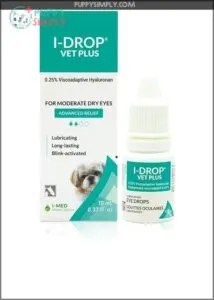
Sometimes, your dog’s eyes just need a little TLC, and that’s where I-DROP VET PLUS with hyaluronic acid comes in. It’s like giving your furry friend’s eyes a soothing sip of water—only better.
This 10-mL formula uses viscoadaptive biopolymers to deliver long-lasting hydration while washing away irritants like dust, allergens, and debris.
What makes hyaluronic acid special? It’s a hydration powerhouse, holding up to 1,000 times its weight in water, which means instant comfort for dogs with dry eye or keratoconjunctivitis sicca.
Studies even show its cross-linked technology helps heal corneal damage 50% faster. If you’ve got a pug or spaniel, breeds easily prone to eye sensitivity, this solution is a game-changer.
With a simple, user-friendly dropper, applying it twice daily is a breeze—well, unless your dog decides eye drops are a new game of “keep away!”
Best For: Dogs suffering from chronic dry eye, eye infections, or tear staining, especially breeds prone to eye sensitivity like pugs and spaniels.
- Long-lasting hydration with hyaluronic acid that soothes and moisturizes.
- Effectively removes debris, allergens, and tear stains for clearer eyes.
- User-friendly dropper makes it simple to apply daily.
- Some dogs might experience no noticeable improvement or discomfort.
- Packaging issues have been reported, though the container remains secure.
- Requires consistent daily use for optimal results, which may not suit all pet owners.
2. Dog Eye Rinse Gentle Formula
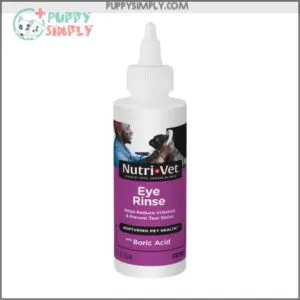
When your dog’s eyes need a little TLC, Nutri-Vet Eye Rinse is a gentle yet effective option.
Designed with boric acid and saline, it mirrors natural tears, soothing sensitive eyes while clearing debris and fighting germs.
Regular use can tackle tear stains and ease redness caused by pollen, dust, or irritants.
Apply 2-3 drops daily for cleaner, refreshed eyes.
Safe for all breeds and ages, it’s a trusty choice for everyday care.
For serious issues, always check with your vet!
Best For: Dogs of all breeds and ages needing gentle eye cleaning and relief from irritation caused by allergens or debris.
- Safe and non-irritating for sensitive eyes.
- Helps reduce tear stains and redness.
- Supports daily eye hygiene and comfort.
- Not a cure for severe eye infections.
- Requires consistent use for noticeable results.
- Less effective for chronic eye conditions.
3. Sterile Eye Wash for Dogs and Cats

Every pet deserves clear, comfortable eyes, and Sterile Eye Wash for Dogs and Cats delivers just that.
Made with 98.5% purified water, this solution mirrors your pet’s natural tear pH, gently flushing out dirt, allergens, and crusty buildup. The best part? It’s sting-free, so your furry friend won’t dread clean-up time.
The convenient squeeze bottle makes application effortless—squeeze directly into the eye or dab with a soft cloth for precision. It’s perfect for daily maintenance, keeping irritation and infections at bay before they begin.
Owners of larger breeds might find themselves refilling often, as it takes more to thoroughly clean those big eyes.
Affordable and versatile, this eye wash is a daily hero for pet parents who value their fur baby’s eye health!
Best For: Pet owners seeking a gentle, sting-free solution to maintain their dog or cat’s eye health daily.
- Sting-free formula that pets tolerate well.
- Convenient squeeze bottle for easy application.
- Effectively flushes out dirt, allergens, and irritants.
- May require frequent refills for larger breeds.
- Not ideal for pets with severe eye conditions needing specialized care.
- Some users may prefer a pre-soaked pad option for convenience.
4. Burt’s Bees Dog Tear Stain Remover
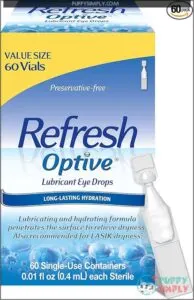
Keeping your pup’s face clean and bright just got easier with Burt’s Bees Dog Tear Stain Remover.
This 99.9% natural formula, featuring soothing chamomile, gently tackles tear stain buildup without harsh chemicals.
Designed to fit your dog’s unique pH, it’s safe for daily use and won’t irritate sensitive skin.
Simply dampen a cotton ball, wipe below the eyes, and repeat daily.
Results may take 15-30 days, but great things take time.
Say goodbye to stains, naturally and stress-free!
Best For: Dog owners seeking a natural, gentle solution for reducing tear stains over time.
- Made with 99.9% natural ingredients, including chamomile.
- Safe for daily use without irritating sensitive skin.
- PH balanced specifically for dogs.
- Results take 15-30 days to become visible.
- Requires daily application for effectiveness.
- Not effective for severe or deep-seated tear stains.
5. Dog Eye Cleaner Drops

Ever wonder what makes a great eye cleaner for your dog? Dog Eye Cleaner Drops are a standout choice for tackling common eye issues like discharge, irritation, and allergies.
Designed with care, these drops use 99.9% natural ingredients—free from harsh chemicals, dyes, and parabens—making them gentle yet effective for puppies and adult dogs alike. They are veterinarian-trusted, and help remove dirt, debris, and tear stains while providing soothing relief.
The formula contains chamomile, known for its calming properties, ensuring your dog feels comfortable during and after application. A precision applicator makes the process easy, delivering the solution directly where it’s needed.
For consistent results, apply daily with a clean cotton ball, as directed. While these drops work wonders for routine care, they’re not a cure-all—serious conditions like cataracts may still require surgical intervention. Keep your dog’s eyes clean and bright with regular use!
Best For: Dogs prone to tear stains, debris buildup, or needing gentle, natural eye care.
- Results can vary depending on the dog’s breed and tear stain severity.
- Some users report no improvement or worsened conditions after use.
- A few complaints about the bottle design causing spills.
- Made with 99.9% natural ingredients and chamomile for a soothing effect.
- Free from harsh chemicals, making it safe for puppies and adult dogs.
- Designed to remove tear stains and debris effectively with regular use.
6. Vetericyn Plus Eye Wash for Pets

Caring for your dog’s eyes is easy with Vetericyn Plus Eye Wash, a trusted go-to for irritated eyes.
This sting-free solution works like a gentle shower for your pet’s eyes, flushing away debris, pollen, and mucous while helping reduce tear stains.
Its secret weapon, hypochlorous acid, tackles bacteria, fungus, and viruses with surgical precision—no harsh chemicals or side effects to fret over.
Perfect for daily use, it’s a vet-approved formula safe for dogs of all ages.
Whether your pup’s been romping through fields or battling allergies, this versatile product provides quick, soothing relief.
Think of it as a daily hug for their peepers!
Best For: Pet owners seeking a safe, gentle, and effective eye wash for daily use or to address eye irritation in dogs and other animals.
- Sting-free formula safe for all animals and ages.
- Effective at tackling bacteria, fungus, and viruses with hypochlorous acid.
- Provides quick relief for allergies, tear stains, and debris removal.
- Applicator tip design may lead to wastefulness.
- Smaller bottle size may not last long with frequent use.
- Leakage issues reported during shipping.
How to Apply Eye Drops to Dogs
Applying eye drops to your dog might seem tricky at first, but with the right technique, it gets much easier.
By staying calm, preparing properly, and using a gentle approach, you can help keep your dog’s eyes healthy and comfortable.
Preparing Your Dog for Eye Drop Application
Applying eye drops to your dog can be an easy, stress-free experience with the right approach. Success starts with calming techniques, positive reinforcement, and proper preparation.
Here are steps to guarantee smooth application:
- Secure Positioning: Choose a quiet, comfortable spot like their bed. Your dog should feel safe and relaxed before you begin.
- Gradual Introduction: If they’ve never had eye drops, start with an empty dropper. Gently simulate the process during short sessions to build trust.
- Supply Preparation: Have everything ready—drops, a clean cloth for wiping, and treats. This reduces distractions and keeps the process quick.
- Positive Reinforcement: Treats and praise before, during, and after the application keep the experience positive. Pairing the process with rewards can make your dog more cooperative.
With these dog eye care tips, administering eye drops to dogs becomes easier, safer, and less intimidating for both of you.
Proper Technique for Administering Eye Drops
Administering eye drops to dogs can feel intimidating, but with the right technique, it doesn’t have to be.
- Start clean: Make sure your hands and the dropper are clean to prevent infection. Gather all necessary cleaning supplies nearby.
Eyelid Handling: Gently hold your dog’s chin and use two fingers to pull the lower eyelid down slightly, creating a small pocket. Avoid pinching or pulling too hard.
Drop Aiming: Hold the dropper just above the eye—steady your hand to avoid touching the eyelid or lashes. Squeeze the precise dosage as prescribed.
Positive Reinforcement: Soft praise, gentle pats, and a treat can transform eye drop usage from a struggle into a moment of bonding.
Following these eye drop application techniques guarantees success!
Frequency and Duration of Eye Drop Treatment
The success of dog eye drop treatment depends on following a precise dosage schedule and completing the full treatment length prescribed by your veterinarian.
Even if your dog’s eyes seem better, stopping early can cause setbacks.
Stick to the recommended eye drop frequency, typically 2-3 times daily.
Consistency is key to effective recovery.
To simplify routines:
- Set reminders on your phone so you never miss a dose.
- Track progress daily, noting changes like reduced redness or discharge.
- Double-check the dosage to confirm every drop counts.
Be patient with dog eye drop usage—each step supports proper healing.
Combined with monitoring progress and veterinary guidance, consistent application helps protect your dog’s vision and comfort.
Potential Challenges and Solutions
Handling eye drop challenges can feel like chasing your tail. If application resistance happens, cradle your pup’s head, using treats as bribes.
Watch for side effects like irritation from expired eye drops or incorrect dosage. Emerging research explores the use of anticataract eye drops for canine vision.
Struggling with long-term use or affordability issues? Consult your vet for alternatives.
| Problem | Cause | Solution |
|---|---|---|
| Application resistance | Squirming or pulling | Gentle handling, treats |
| Side effects | Eye irritation | Stop use, call vet |
| Long-term use costs | Frequent prescriptions | Explore cheaper options |
Monitoring Your Dog’s Response to Eye Drops
Once the dog eye drops are in play, it’s time to observe their impact.
Keep an eye out for key signs that signal the treatment’s progress—or lack thereof.
Here are four key things you should monitor:
- Redness Changes: Is the redness fading? Less redness hints that healing is underway.
- Discharge Consistency: Watery discharge is fine, but thick or colored discharge could mean infection or eye drop side effects.
- Behavior Shifts: Has your pup stopped pawing, rubbing, or squinting? These changes show improved comfort.
- Vision Improvement: Your dog should navigate with more confidence as symptoms ease.
If problems persist or worsen, schedule a veterinary follow-up to reassess your dog’s condition.
Choosing The Right Eye Drops for Your Dog
Finding the right eye drops for your dog means considering their specific symptoms, safety needs, and the ease of use.
Collaborate with your veterinarian and review ingredient labels carefully to verify the treatment is effective and safe.
Consulting With Your Veterinarian
Regarding your dog’s eyes, don’t take guesses—schedule a veterinary consultation.
Your vet performs a detailed examination to uncover not just obvious signs like redness or discharge but hidden issues like glaucoma or infections.
Tests, including pressure checks and fluorescein staining, help reveal the underlying causes of the problem.
They’ll provide medication guidance—whether your dog needs basic saline drops or prescription treatments targeting specific conditions.
For some breeds prone to eye issues, such as pugs or bulldogs, your vet may highlight their breed predisposition when making eye drop recommendations.
Follow-up visits make certain treatments deliver long-term benefits, protecting their vision and overall dog eye health.
In emergencies, referrals to specialists may also be suggested for advanced veterinary care.
Considering Your Dog’s Specific Eye Condition
Choosing the right dog eye drops starts with understanding your pet’s unique needs.
Symptoms like redness, discharge, or squinting might indicate an eye infection, dog eye allergies, or the need for dry eye relief.
Start by evaluating symptom severity—minor irritations may only need saline rinses, while conjunctivitis treatment or antibiotics could be necessary for more serious conditions.
Don’t forget breed predispositions.
Pugs and Shih Tzus, for example, are prone to drying and injuries due to their large, exposed eyes.
Also, weigh any underlying causes, like cataracts or diabetes, and watch for medication interactions that could affect eye infection treatments.
While surgery is often needed, anticataract eye drops show some promise.
Remember, holistic approaches work best.
A veterinarian’s advice plus your close observation guarantees the perfect fit for healthy, comfortable eyes.
- Symptom severity matters: Pay close attention to behaviors like squinting or rubbing.
- Breed predispositions are key: Larger eyes mean extra care.
- Underlying causes count: Don’t overlook systemic health issues.
- Medication interactions occur: Double-check with your vet!
Evaluating Ingredients and Potential Side Effects
When picking dog eye drops, you’ve got to check those eye drop ingredients for safety and vet approval. Harmful chemicals, like naphazoline and brimonidine found in Human Drops, can seriously mess with your pup’s heart or blood pressure. Stick with dog eye drops made just for pets to dodge those risks.
Preservative Concerns? Preservative-free formulas are awesome for sensitive eyes, cutting down irritation. Keep Breed Predispositions in mind, too! Watch out for allergic reactions or drug interactions, especially if your dog’s on other meds.
If you spot redness or pawing, that’s a red flag. Chat with your vet ASAP. Long-Term Effects matter, so always be cautious!
- Imagine a tiny magnifying glass, carefully examining each ingredient.
- Picture a shield, protecting your dog’s eyes from Harmful Chemicals.
- Think of a happy, comfortable dog, free from irritation.
Ease of Use and Application Method
Making eye drop application easier isn’t just about the product—it’s also about technique and cooperation.
Choose dog eye drops with ergonomic droppers designed for a solid grip; these help prevent slips and wasted medicine.
A tightly-sealed cap preserves sterility, guaranteeing safe use over time.
Drops that dispense a precise amount are a plus, minimizing mess while maintaining dosage accuracy.
Dogs can be impatient, so quick, steady administration techniques go a long way in securing their cooperation.
Pairing the process with gentle words or treats builds trust, turning a stressful moment into a manageable one.
Eye drop tips like swift handling and calm energy can guarantee a hassle-free experience during frequent treatments.
Cost and Value Considerations
When looking for dog eye drops, balancing cost and value is key.
Quality care doesn’t have to break the bank if you’re strategic. A little planning can save money while ensuring your dog gets relief.
Here’s how to make smart decisions:
- Brand Comparison: Compare trusted names with generic options. Many affordable alternatives deliver similar results. Check eye drop reviews for insights.
- Long-Term Expenses: Higher-priced drops may prevent complications, saving on future vet bills.
- Ingredient Value: Focus on drops with proven, safe ingredients, ensuring effective treatment without extra costs.
- Insurance Coverage: Consider pet insurance for prescription drops to reduce recurring expenses.
Investing wisely means better care without overspending.
Frequently Asked Questions (FAQs)
What is the best eye drops for dogs?
Think of eye care as a window to your dog’s comfort.
For mild irritations, try Dr. Goodpet Eye-C drops.
For infections, consult your vet for antibiotics like Terramycin.
Always prioritize safety and consultation!
How to put eye drops or ointments in your pet?
Gently hold your dog’s head steady, tilt it slightly upward, and wipe any debris.
Pull down the lower eyelid, apply the drops or ointment, then release.
Reward with praise or treats to ease future applications.
What are antibiotic eye drops for dogs?
Imagine knights protecting a castle—antibiotic eye drops are your dog’s defenders.
They fight bacterial infections, like conjunctivitis, safeguarding your pet’s vision.
Popular ones include Terramycin and Ciprofloxacin, prescribed by vets for swift, targeted relief.
What are the best eye drops for a dog?
The best dog eye drops depend on your dog’s needs.
For minor irritations, try Vets Preferred Advanced Eye Wash.
For dry eyes, OphtHavet is exceptional.
Serious infections might need vet-prescribed antibiotic drops like Ciprofloxacin.
Can human eye drops be used on dogs?
Using human eye drops on dogs is like trying to fit a square peg into a round hole—it doesn’t work.
They’re formulated differently and can harm your dog’s eyes.
Always consult your vet first!
What is a home remedy for dog eye drops?
You can safely flush your dog’s eyes with a sterile saline solution or distilled water to remove debris or soothe irritation.
Avoid anything medicated; always check with your vet before trying home remedies.
Which human eye drops are safe for dogs?
Stick to preservative-free human saline or lubricating eye drops in emergencies, but always confirm with a vet first.
Human medicated drops aren’t safe—different pH and ingredients can harm dogs’ eyes and worsen their condition.
What are the best drops for dry eyes in dogs?
For dry eyes in dogs, lubricating drops like OptixCare or drops with hyaluronic acid work wonders.
They hydrate, soothe irritation, and support eye health.
Always check with your vet before starting any treatment.
What do vets give dogs for eye infections?
When a dog’s eyes scream for help, vets often prescribe antibiotic drops or ointments like Terramycin or Gentamicin.
These target bacterial infections fast, easing redness and discharge, while keeping your pup’s vision safe.
What are the best eye drops for dogs with dry eyes?
For dogs with dry eyes, lubricating drops like OphtHavet Ophthalmic Ointment or cyclosporine drops work wonders.
They hydrate and protect, reducing irritation.
Always check with your vet first to confirm the drops are safe and effective.
Conclusion
Imagine this: your dog’s irritated eyes finally sparkle again after finding the best eye drops for dogs.
Whether you’re flushing debris with a gentle wash, tackling dry eye with moisturizing gels, or using vet-prescribed antibiotics, choosing solutions suited to your pup’s condition is key.
Always consult your veterinarian to guarantee safe, effective care.
With proper application and monitoring, you’ll safeguard your furry friend’s vision and comfort, proving that even small drops can make a big difference.
- https://www.nature.com/articles/nature14650
- https://www.science.org/content/article/eye-drops-could-dissolve-cataracts
- https://sitn.hms.harvard.edu/flash/2015/can-cataracts-be-cured-with-a-simple-eyedrop/
- https://petkeen.com/bump-on-dogs-eye-vet-answer/
- https://pangovet.com/?utm_source=dogster&utm_medium=article&utm_campaign=dog_eye_issues/

